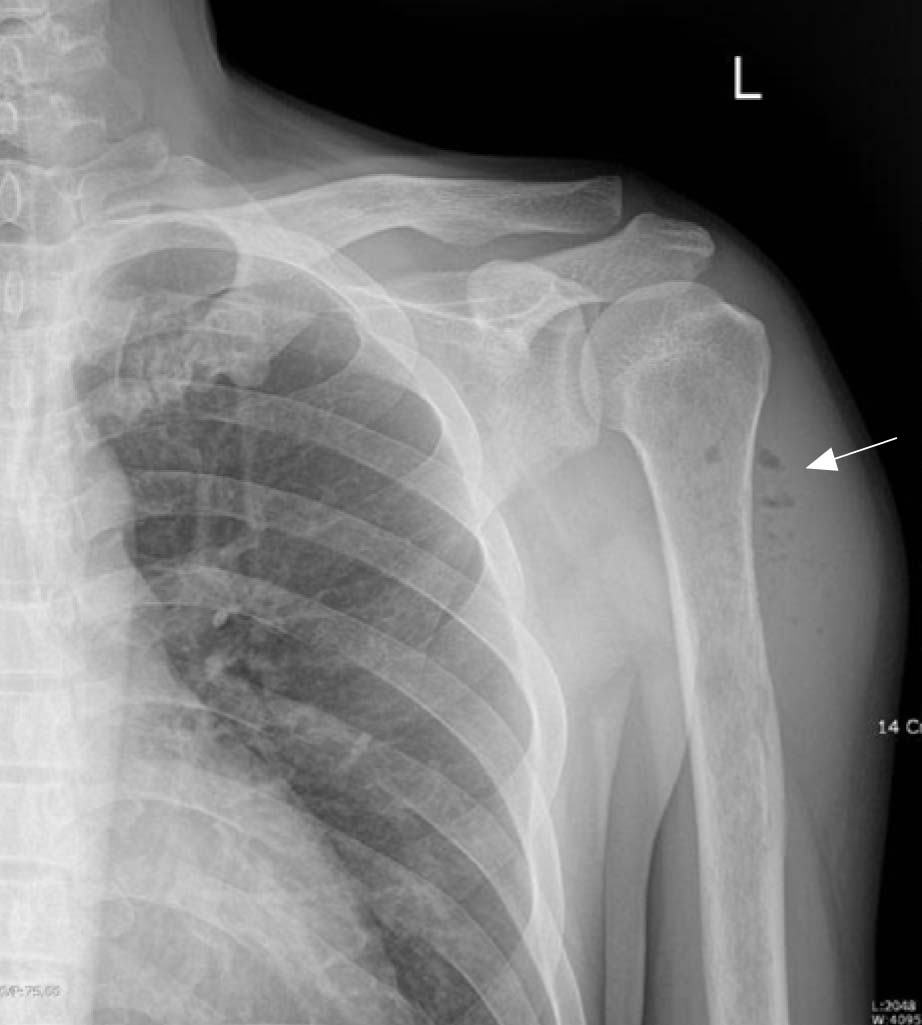Infect Chemother.
2008 Oct;40(5):281-283. 10.3947/ic.2008.40.5.281.
A Case of Humeral Osteomyelitis and Soft Tissue Abscess Accompanied with Streptococcus anginosus Bacteremia
- Affiliations
-
- 1Department of Internal Medicine, Gachon University, Gil Medical Center, Incheon, Korea. yspark@gilhospital.com
- 2Department of Laboratory Medicine, Gachon University, Gil Medical Center, Incheon, Korea.
- KMID: 2285053
- DOI: http://doi.org/10.3947/ic.2008.40.5.281
Abstract
- Streptococcus anginosus is a normal flora found in multiple body sites and belongs to the Streptococcus milleri group. It has often been associated with pyogenic infection, such as perio-dontitis, endocarditis, pulmonary abscess and abdominal or cerebral abscess. Also uncommonly, it can cause osteomyelitis. A 42-year-old man was admitted due to gastric ulcer perforation. At 12th hospital day, left humeral osteomyelitis and soft tissue abscess developed. Streptococcus anginosus grew in blood culture. He was treated with intravenous penicillin and surgical debridement of the necrotic tissue which lead to a satisfactory result. We report a rare case of Streptococcus anginosus-induced humeral osteomyelitis and soft tissue abscess.
Keyword
MeSH Terms
Figure
Cited by 1 articles
-
A Case of Fournier's Gangrene Caused by Streptococcus anginosus
Ho Jun Lee, Seouk Chan Ko, Sung Du Kim, Yoon Jeong Kim, Myoung-Sook Koo, Min-Su Kim, Jae-phil Choi
Infect Chemother. 2011;43(1):60-63. doi: 10.3947/ic.2011.43.1.60.
Reference
-
1. Mirzanejad Y, Stratton CW. Mandell GL, Bennet JE, Dolin R, editors. Streptococcus angionosus Group. Principles and Practice of Infectious Diseases. 2005. 6th. Churchill Livingstone;2451–2455.2. Gray T. Streptococcus anginosus group: Clinical significance of an important group of pathogens. Clin Microbiol Newsl. 2005. 27:155–159.
Article3. Nagamune H, Whiley RA, Goto T, Inai Y, Maeda T, Hardie JM, Kourai H. Distribution of the intermedilysin gene among the anginosus group streptococci and correlation between intermedilysin production and deep-seated infection with Streptococcus intermedius. J Clin Microbiol. 2000. 38:220–226.
Article4. Jacobs JA, Schot CS, Schouls LM. Haemolytic activity of the Streptococcus milleri group' and relationship between haemolysis restricted to human red blood cells and pathogenicity in S. intermedius. J Med Microbiol. 2000. 49:55–62.
Article5. Whiley RA, Beighton D, Winstanley TG, Fraser HY, Hardie JM. Streptococcus intermedius, Streptococcus constellatus, and Streptococcus anginosus (the Streptococcus milleri group): association with different body sites and clinical infections. J Clin Microbiol. 1992. 30:243–244.
Article6. Claridge JE 3rd, Attorri S, Musher DM, Hebert J, Dunbar S. Streptococcus intermedius, Streptococcus constellatus, and Streptococcus anginosus ("Streptococcus milleri group") are of different clinical importance and are not equally associated with abscess. Clin Infect Dis. 2001. 32:1511–1515.7. Morita E, Narikiyo M, Yokoyama A, Yano A, Kamoi K, Yoshikawa E, Yamaguchi T, Igaki H, Tachimori Y, Kato H, Saito D, Hanada N, Sasaki H. Predominant presence of Streptococcus anginosus in the saliva of alcoholics. Oral Microbiol Immunol. 2005. 20:362–365.
Article8. Bert F, Bariou-Lancelin M, Lambert-Zechovsky N. Clinical significance of bacteremia involving the "Streptococcus milleri" group: 51 cases and review. Clin Infect Dis. 1998. 27:385–387.
Article9. Bantar C, Fernandez Canigia L, Relloso S, Lanza A, Bianchini H, Smayevsky J. Species belonging to the "Streptococcus milleri" group: antimicrobial susceptibility and comparative prevalence in significant clinical specimens. J Clin Microbiol. 1996. 34:2020–2022.
Article10. Limia A, Jiménez ML, Alarcón T, López-Brea M. Fiv-eyear analysis of antimicrobial susceptibility of the Streptococcus milleri group. Eur J Clin Microbiol Infect Dis. 1999. 18:440–444.
Article
- Full Text Links
- Actions
-
Cited
- CITED
-
- Close
- Share
- Similar articles
-
- A Case of Group F Streptococcal Bacteremia in MPGN Patient
- Acute Acalculous Cholecystitis with Bacteremia Caused by Streptococcus anginosus Following Dental Procedure in a Previously Healthy Adolescent
- A Case of Vertebral Osteomyelitis with Spinal Epidural Abscess Caused by Streptococcus constellatus
- Gas Gangrene Caused by Streptococcus anginosus
- Septicemic Melioidosis Presenting as Head and Neck Abscesses



